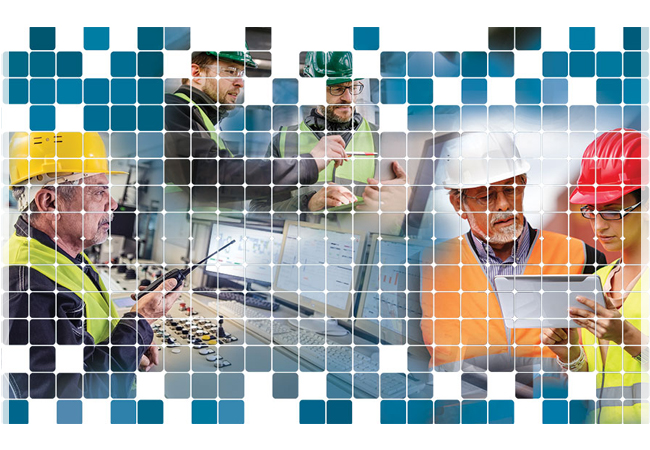Currency
March 29, 2018

Once upon a time, dangers in the workplace focused solely on equipment issues or malfunctions. In today’s work environment you must be aware of other risks such as extreme weather conditions, internal threats and updates on the location of onsite construction. Plans to keep employees safe must be adjusted accordingly as work environments change.
According to the National Safety Council, two million American workers report having been victims of workplace violence every year. Employees are often the first witnesses of any workplace violence and two-way communication can allow internal management or public safety officials to respond faster and prevent the situation from escalading any further. Tools like panic buttons can provide immediate notification of any strange or dangerous events, helping to reduce violent incidents.
Implementing two-way communication tools between employees, management or public safety officials is revolutionizing safety procedures (planning, drills, etc.) in the workplace. During even the most unprecedented of situations, two-way instant communication has the power to increase employee engagement and situational awareness. Use of employee notification systems to communicate in situations such as severe weather events, power outages and fire alarms can reduce business disruptions and prevent injury. Notifications can be sent in the form of a phone call, email, text or through a personal safety application to benefit your emergency plans.
A two-way communication tool enables employees to respond to a notification with relevant information or a personal status update confirming their safety during a crisis. As a result, enhanced communication drives greater situational awareness for all members of the workplace, whether working onsite or remote.
Receiving information quickly and effectively during an emergency is necessary for more than just employees in the workplace. For instance, up-to-date information is critical to improving the emergency response speed and awareness for public safety officials, especially regarding facility information such as key points of access or the location of utility valves. Protecting all employees, beyond location
It’s also important to consider the safety and security needs of employees working remotely or alone in the field. Without the benefit of physical security protection that comes from a traditional office environment, two-way communication allows for lone workers to check in proactively or in a situation they feel uncomfortable. In reverse, this type of communication also enables management to send targeted notifications based on employee location.
During recent major storms, two-way communication was an essential functionality for organizations both small and large to notify employees of office closures and check on their safety, no matter their location.

Anonymous tips allow witnesses of suspicious incidents or behaviors to report eyewitness accounts to management, without concerns of retaliation or judgment for the information they are sharing. Whether the witnessed incident is a minor facility fix or a potentially dangerous situation, it’s important to give people a safe and secure way to report valuable information.
Even small issues in the workplace can greatly affect morale if employees feel the situation is not handled appropriately. Two-way communication creates a platform for a safer work environment by establishing better situational awareness and multi-modal, targeted communication with employees.
According to the National Safety Council, two million American workers report having been victims of workplace violence every year. Employees are often the first witnesses of any workplace violence and two-way communication can allow internal management or public safety officials to respond faster and prevent the situation from escalading any further. Tools like panic buttons can provide immediate notification of any strange or dangerous events, helping to reduce violent incidents.
Implementing two-way communication tools between employees, management or public safety officials is revolutionizing safety procedures (planning, drills, etc.) in the workplace. During even the most unprecedented of situations, two-way instant communication has the power to increase employee engagement and situational awareness. Use of employee notification systems to communicate in situations such as severe weather events, power outages and fire alarms can reduce business disruptions and prevent injury. Notifications can be sent in the form of a phone call, email, text or through a personal safety application to benefit your emergency plans.
Increased information for all
A two-way communication tool enables employees to respond to a notification with relevant information or a personal status update confirming their safety during a crisis. As a result, enhanced communication drives greater situational awareness for all members of the workplace, whether working onsite or remote.
Receiving information quickly and effectively during an emergency is necessary for more than just employees in the workplace. For instance, up-to-date information is critical to improving the emergency response speed and awareness for public safety officials, especially regarding facility information such as key points of access or the location of utility valves. Protecting all employees, beyond location
It’s also important to consider the safety and security needs of employees working remotely or alone in the field. Without the benefit of physical security protection that comes from a traditional office environment, two-way communication allows for lone workers to check in proactively or in a situation they feel uncomfortable. In reverse, this type of communication also enables management to send targeted notifications based on employee location.
During recent major storms, two-way communication was an essential functionality for organizations both small and large to notify employees of office closures and check on their safety, no matter their location.

First-hand eyewitness accounts
Anonymous tips allow witnesses of suspicious incidents or behaviors to report eyewitness accounts to management, without concerns of retaliation or judgment for the information they are sharing. Whether the witnessed incident is a minor facility fix or a potentially dangerous situation, it’s important to give people a safe and secure way to report valuable information.
Communication moving forward
Even small issues in the workplace can greatly affect morale if employees feel the situation is not handled appropriately. Two-way communication creates a platform for a safer work environment by establishing better situational awareness and multi-modal, targeted communication with employees.









